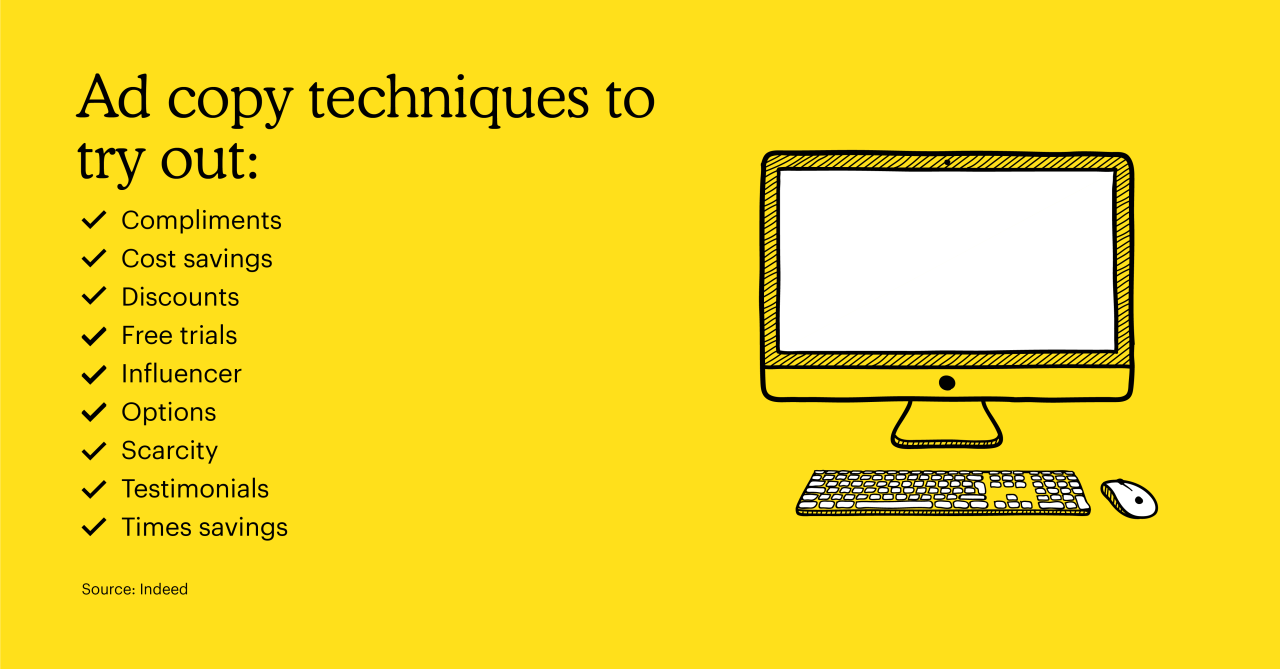
Ad Copy Marketing Explained A Deep Dive
Ad copy marketing explained is the key to captivating audiences and driving conversions. It’s more than just words on a page; it’s a strategic dance between understanding your target audience and crafting persuasive messages that resonate. This comprehensive guide will dissect the elements of effective ad copy, from defining core principles to measuring campaign impact, and ultimately reveal how to craft compelling ad copy that builds brands and fosters customer loyalty.
We’ll explore different types of ad copy, analyze compelling examples, and discover the secrets behind successful campaigns across various media. From crafting attention-grabbing headlines to optimizing for different platforms, this in-depth exploration covers everything you need to know about creating powerful and effective ad copy.
Defining Ad Copy Marketing
Ad copy marketing is the art and science of crafting compelling written messages to persuade audiences to take a desired action. It’s more than just catchy phrases; it’s a strategic blend of understanding your target audience, communicating your value proposition, and ultimately driving conversions. From social media posts to website landing pages, ad copy acts as the voice of your brand, influencing consumer perception and shaping purchasing decisions.Effective ad copy hinges on several key principles.
Clear and concise language is paramount, ensuring your message resonates with the reader quickly. A strong call to action is crucial, prompting the audience to act immediately. Understanding the target audience’s needs and motivations allows you to tailor the copy to their specific interests, building trust and engagement. Ultimately, effective ad copy is persuasive, informative, and engaging, leaving a lasting impression on the reader.
Core Principles of Effective Ad Copy
The success of ad copy hinges on several key principles. Understanding your target audience is crucial; their demographics, interests, and pain points dictate the tone and language of your copy. Strong calls to action are imperative, prompting immediate responses and directing readers to desired outcomes. Finally, the copy should be concise and compelling, ensuring the message resonates quickly and memorably.
Types of Ad Copy Marketing Strategies
Various strategies can be employed in ad copy marketing, tailored to different campaigns and objectives. Direct response copy focuses on immediate action, often using persuasive language and clear calls to action. Brand-building copy aims to establish brand recognition and positive associations, using storytelling and evocative language. Informative copy provides detailed information about products or services, building trust and credibility.
Different strategies suit different marketing goals.
Comparison of Ad Copy Styles
| Style | Focus | Tone | Example |
|---|---|---|---|
| Persuasive | Influencing purchase decisions | Enthusiastic, authoritative, often using emotional appeals | “Experience the ultimate comfort with our new sofa – order yours today!” |
| Informative | Providing detailed information | Neutral, objective, focused on facts and features | “Our new software features enhanced security protocols, increased efficiency, and simplified user interfaces.” |
| Humorous | Creating engagement and brand memorability | Lighthearted, playful, using wit and humor | “Our new coffee is so strong, it’ll wake up your dead grandma!” (used cautiously) |
This table demonstrates the diverse styles of ad copy, highlighting the varying approaches to influencing audiences. Each style employs a distinct tone and focus to achieve specific marketing goals. The choice of style depends heavily on the campaign’s objectives and target audience.
Elements of Compelling Ad Copy

Crafting effective ad copy is crucial for capturing attention and driving conversions. It’s more than just words on a page; it’s a carefully constructed narrative designed to connect with the target audience and motivate them to take action. This section delves into the key elements that make ad copy compelling.Clear and concise language is paramount in ad copy.
Long, convoluted sentences and jargon alienate readers and obscure the message. Short, punchy sentences, combined with active voice, ensure the core message is quickly understood and remembered. Using simple language that resonates with the target audience is key to making the copy relatable and easy to grasp.
Clear and Concise Language
Clear and concise language is vital for effective ad copy. Ambiguity and unnecessary complexity hinder understanding and diminish the impact of the message. Using precise language that directly communicates the value proposition and benefit to the reader ensures clarity and engagement. Employing short, active sentences and avoiding technical jargon or overly complex vocabulary is essential. A good rule of thumb is to aim for language that a typical member of your target audience would readily understand.
Strong Call to Action
A compelling call to action (CTA) is indispensable in ad copy. It guides the reader towards the desired action, whether it’s making a purchase, visiting a website, or signing up for a newsletter. A strong CTA is specific, concise, and visually distinct. It uses action verbs and encourages immediate response. A clear and prominent CTA is essential to converting potential customers into actual buyers.
Effective Headlines
Headlines are the first impression a reader gets. A captivating headline immediately grabs attention and entices the reader to delve deeper into the ad copy. Intriguing questions, powerful statements, or unique propositions are some of the ways to create compelling headlines. Examples of effective headlines include: “Unlock Your Financial Freedom Today,” “Experience the Difference,” or “Stop Wasting Time on Inefficient Processes.”
Visuals and Imagery
Visuals play a crucial role in supporting ad copy. High-quality images and graphics enhance the message and create a more engaging experience for the reader. Relevant visuals, such as product shots, lifestyle imagery, or infographics, should be integrated into the ad copy to convey the value proposition in a compelling and memorable way.
Unique Selling Proposition (USP), Ad copy marketing explained
A unique selling proposition (USP) is the key differentiator for a product or service. It highlights what makes your offering superior to the competition. Crafting a strong USP requires identifying what makes your product or service stand out in the market and clearly communicating that value to the target audience. A strong USP should be reflected in all aspects of your ad copy.
Key Elements of a Successful Ad Campaign
| Element | Description | Importance ||—|—|—|| Target Audience | Understanding the demographics, psychographics, and needs of the target audience is crucial. | Identifying the right audience is essential for effective communication. || Value Proposition | Clearly articulating the benefits and value of the product or service. | The value proposition highlights the advantages for the customer. || Call to Action (CTA) | Specific instructions on what the audience should do next.
Understanding ad copy marketing is key for any business, big or small. But if you’re a small business owner, knowing how to choose the right social media packages can make all the difference in your ad copy’s effectiveness. Consider factors like your budget and target audience when evaluating options like small business social media packages how to pick one.
Ultimately, the best ad copy will always be tailored to your specific audience and goals, making it the crucial final piece of the puzzle.
| A strong CTA drives conversions and action. || Visuals | High-quality images and graphics that enhance the message and create a memorable experience. | Visuals complement the text and capture attention. || Messaging | Concise and clear language that resonates with the target audience. | Effective messaging ensures understanding and engagement.
|| Brand Consistency | Maintaining a consistent brand identity across all marketing materials. | Brand consistency creates a recognizable and trustworthy image. |
Crafting Effective Ad Copy
Crafting effective ad copy is more than just writing catchy phrases; it’s about understanding your audience, communicating your message clearly, and driving conversions. This crucial aspect of marketing hinges on tailoring your language and style to resonate with your specific target audience. Successful ad copy effectively connects with readers on an emotional level, inspiring action and building brand loyalty.A well-crafted ad copy speaks directly to the needs and desires of the target audience.
So, ad copy marketing explained boils down to crafting compelling messages that sell. But to truly capture attention, you need to make sure your ad copy is easy to read. Following blog post formatting tips, like using clear headings and bullet points, can drastically improve how your ad copy is perceived by the reader. blog post formatting tips enhance readability are key to engaging readers and ultimately driving conversions.
Good formatting translates to a more positive experience, ultimately improving your ad copy’s effectiveness.
It’s not about simply listing features; it’s about showcasing how those features solve problems and enhance lives. This requires a deep understanding of your audience’s values, motivations, and pain points. The more effectively you address these, the more likely your ad copy is to capture attention and drive engagement.
Tailoring Ad Copy for Different Target Audiences
Understanding your target audience is fundamental to crafting effective ad copy. Different demographics, psychographics, and needs demand tailored approaches. A teenager will respond differently to an advertisement than a senior citizen. A professional seeking a career advancement will react to different messaging than a stay-at-home parent. Recognize the diverse factors influencing your audience and adjust your language, tone, and imagery accordingly.
Storytelling Techniques in Ad Copy
“Stories are more than just entertainment; they’re a powerful way to connect with people on a deeper level.”
Storytelling in advertising goes beyond simply describing products or services. It creates an emotional connection with the audience by weaving a narrative that resonates with their values, aspirations, and experiences. Incorporating compelling characters, conflicts, and resolutions can make your ad copy memorable and impactful.
Ad Copy Formats
Different platforms require different approaches. Print ads benefit from concise language and impactful visuals. Online ads often employ dynamic elements like animations and interactive features to capture attention. Social media ads frequently leverage humor, relatability, and engagement to encourage interaction. The choice of format should align with the platform’s unique characteristics and target audience.
Ad copy marketing explained is all about crafting compelling messages to entice customers. Knowing how to effectively connect with your target audience is key. To truly stand out, consider how to get verified on Instagram; 7 essential steps can dramatically increase your reach. how to get verified on instagram 7 essential steps will help you create a strong online presence, which ultimately supports your ad copy efforts.
Ultimately, understanding the nuances of ad copywriting is critical for a successful marketing campaign.
- Print Ads: Focus on strong visuals and concise, impactful text. Use bold headings and short paragraphs to quickly convey the key message. Think high-quality imagery and short, memorable taglines.
- Online Ads: Employ a variety of elements, such as video, interactive elements, and call-to-actions (CTAs). Keep the copy concise and compelling to maintain user engagement on the page.
- Social Media Ads: Utilize engaging visuals, short videos, and interactive elements to encourage interaction. Emphasize relatability and humor, and utilize trending topics and hashtags to maximize visibility.
Steps in Writing Effective Ad Copy
Writing effective ad copy requires a structured approach. This systematic method helps ensure that the copy aligns with the target audience and achieves its desired goals.
| Step | Description |
|---|---|
| 1 | Define the objective: Clearly articulate what you want the ad to achieve (e.g., brand awareness, lead generation, sales). |
| 2 | Identify the target audience: Understand their demographics, psychographics, and needs. |
| 3 | Develop a compelling message: Craft a clear and concise message that resonates with the target audience. |
| 4 | Craft a compelling story: Weave a narrative that connects with the audience on an emotional level. |
| 5 | Write the copy: Write the ad copy, focusing on clarity, conciseness, and engagement. |
| 6 | Proofread and revise: Ensure the copy is free of errors and effectively communicates the message. |
| 7 | Test and optimize: Conduct A/B testing to determine which version performs best. |
Importance of A/B Testing
A/B testing is critical for optimizing ad copy performance. It allows marketers to compare different versions of ad copy to determine which performs best. This iterative process enables continuous improvement and ensures the highest possible return on investment. Data-driven decision-making is essential for successful ad copy optimization.
Impact of Emotional Appeals
Emotional appeals in ad copy can significantly impact audience engagement. By tapping into emotions such as joy, fear, or nostalgia, advertisers can create a deeper connection with the target audience, leading to increased memorability and brand loyalty. Emotional appeals can significantly influence consumer decisions.
Measuring the Impact of Ad Copy

Understanding how your ad copy performs is crucial for optimizing your marketing efforts. Effective ad copy not only grabs attention but also drives measurable results. By meticulously tracking key metrics, you gain valuable insights into what resonates with your target audience and what needs refinement. This allows you to allocate resources more strategically and maximize return on investment (ROI).Knowing which metrics to track and how to interpret the data empowers you to make informed decisions.
This is not just about numbers; it’s about understanding the human element behind the data, recognizing trends, and adapting your copy to resonate with your audience.
Key Performance Indicators (KPIs) for Ad Copy
Understanding the significance of different KPIs is paramount to gauging the success of your ad copy. These indicators provide concrete evidence of how well your copy performs across various touchpoints. Tracking these KPIs allows you to see what elements of your copy are working and which need improvement. By monitoring these figures, you can continually refine your approach and improve results.
- Click-Through Rate (CTR): CTR measures the percentage of people who see your ad and actually click on it. A high CTR suggests your ad copy effectively captures attention and entices users to engage. For example, if 1000 people view an ad and 50 click, the CTR is 5%. A low CTR might indicate a need to re-evaluate your ad’s language, imagery, or call to action.
- Conversion Rate: This measures the percentage of clicks that result in a desired action, such as a purchase, sign-up, or form submission. A high conversion rate demonstrates that your ad copy effectively guides users towards completing a desired action. For example, if 50 people click an ad and 10 make a purchase, the conversion rate is 20%. A low conversion rate often points to a need to streamline the user experience or refine the value proposition communicated in the ad copy.
- Cost Per Acquisition (CPA): CPA reflects the cost of acquiring a customer through your ad. A lower CPA signifies greater efficiency in your ad spend. For example, if you spend $1000 on ads and acquire 10 customers, the CPA is $100. Optimizing your copy to reduce CPA is key to maximizing your ROI.
- Engagement Rate: This KPI captures the interaction with your ad, such as likes, shares, comments, or time spent viewing. A high engagement rate indicates that your ad copy effectively captures and maintains the attention of the audience. For example, if an ad receives 50 likes, 20 shares, and 10 comments, the engagement rate is substantial.
Analytics Tools for Measuring Ad Copy Performance
Various analytics platforms provide comprehensive insights into your ad copy’s performance. Choosing the right tool depends on your specific needs and budget. These tools track various data points, enabling you to identify patterns and areas for improvement.
- Google Analytics: A widely used tool, it offers detailed insights into website traffic and user behavior, including how users interact with ads. It provides granular data on sources of traffic, allowing you to understand how well your ad copy performs across various channels.
- Facebook Ads Manager: This platform is specifically designed for Facebook and Instagram ads. It provides detailed metrics on ad performance, including reach, engagement, and conversions, allowing you to refine your approach for these social media platforms.
- AdWords/Google Ads: For search engine advertising, this tool provides data on click-through rates, quality scores, and conversion rates, offering insights into how your copy performs within search results.
Interpreting Ad Copy Analytics Data
Interpreting data requires careful analysis of trends. Identifying patterns in data can highlight strengths and weaknesses in your ad copy. A consistent decline in CTR might indicate a need to refresh your ad’s visuals or wording. Conversely, a sharp increase in conversions could suggest a successful campaign tweak.
Adjusting Ad Copy Based on Performance Data
Analyzing data from your ad campaigns allows you to fine-tune your ad copy for optimal results. If a particular or phrase consistently yields high CTR, consider using it more frequently. If a specific image or headline doesn’t drive conversions, replace it with a different variation. Continuously testing and adjusting your copy ensures you’re staying ahead of the curve and maintaining relevance with your target audience.
Ad Copy Marketing Trends
Ad copy marketing is constantly evolving, driven by technological advancements and shifting consumer behaviors. Understanding these trends is crucial for businesses to stay competitive and connect with their target audience effectively. This exploration delves into the current landscape of ad copy, highlighting emerging technologies, contrasting traditional and modern approaches, and emphasizing the vital role of data analytics.
Recent Trends in Ad Copy Marketing
The modern consumer is bombarded with advertising messages. To stand out, ad copy must be more concise, engaging, and personalized. This necessitates a shift from generic messaging to targeted campaigns tailored to individual preferences. Short-form video ads, interactive content, and personalized product recommendations are becoming increasingly prevalent.
Emerging Technologies and Their Impact on Ad Copy
Artificial intelligence (AI) and machine learning (ML) are revolutionizing ad copy. AI can analyze vast amounts of data to identify consumer preferences, predict campaign performance, and generate personalized ad copy in real-time. Chatbots and virtual assistants are also transforming customer interactions, allowing for more direct and personalized engagement. This data-driven approach is improving campaign effectiveness and efficiency.
Comparison of Traditional and Modern Ad Copy Approaches
Traditional ad copy often relied on broad appeals and mass media. Modern approaches emphasize targeted messaging, personalized experiences, and dynamic content. Traditional methods, like print ads, are not obsolete but are now integrated with digital strategies for maximum impact. Modern approaches are characterized by a focus on user experience and the use of data to personalize the ad copy experience.
Data Analytics in Ad Copy Creation
Data analytics is fundamental to successful ad copy creation. Analyzing website traffic, social media engagement, and customer purchase history allows businesses to tailor their messaging to specific demographics. A/B testing different ad copy variations helps optimize campaigns for maximum impact. This data-driven approach ensures that ad copy resonates with the target audience and achieves desired results.
Key Trends in Ad Copy Marketing
| Trend | Description |
|---|---|
| Personalization | Tailoring ad copy to individual preferences and behaviors. |
| Visual Storytelling | Using compelling visuals and video to convey brand messages. |
| Interactive Experiences | Creating engaging content that allows users to interact with the ad. |
| AI-Powered Copywriting | Leveraging AI to generate personalized and optimized ad copy. |
| Data-Driven Optimization | Using data analytics to measure and improve ad campaign performance. |
Innovative Ad Copy Strategies
Innovative ad copy strategies are emerging that combine creativity with data-driven insights. One example is the use of interactive quizzes or polls within ads to gather user data and personalize the experience. Another is the implementation of dynamic ad copy that adapts to user behavior in real-time. This allows for continuous optimization and maximizes engagement. Examples of successful implementation are often seen in the e-commerce industry.
Case Studies in Ad Copy: Ad Copy Marketing Explained
Ad copy isn’t just about crafting catchy slogans; it’s about understanding the nuances of your audience and crafting a message that resonates. Successful ad copy campaigns often hinge on meticulous planning, targeting, and execution. Let’s delve into some real-world examples that demonstrate how effective ad copy can drive results.Understanding successful ad copy campaigns involves analyzing the strategies used, examining the impactful copy across various media, and pinpointing the key takeaways.
These examples will illuminate how principles of effective ad copy are applied in practice, and crucially, demonstrate the importance of understanding your target audience.
Successful Campaigns in Various Industries
Ad copy effectiveness is not confined to a single industry. It transcends sectors and demonstrates adaptable strategies when used correctly. The following examples highlight campaigns across different industries, demonstrating the broad applicability of effective ad copy.
| Industry | Campaign Name | Key Strategy | Impactful Ad Copy Example | Target Audience | Key Takeaways |
|---|---|---|---|---|---|
| Fast Food | Burger Joint’s “Taste the Difference” | Highlighting unique ingredients and preparation methods. | “Experience the juicy blend of our signature beef, seasoned to perfection. Try our new burger today.” | Young adults and families looking for a delicious and affordable meal. | Emphasizing quality and taste can attract customers. |
| Technology | Tech Innovator’s “Future is Now” | Focusing on innovation and cutting-edge technology. | “Unleash your potential with our revolutionary new software. Experience the future, today.” | Professionals and tech enthusiasts seeking advanced tools and solutions. | Highlighting innovation and technological advancements resonates with the target audience. |
| Fashion | Trendsetter’s “Express Your Style” | Connecting the brand with personal expression and trends. | “Dress your unique personality with our latest collection. Discover your style. Discover Trendsetter.” | Young adults and fashion-conscious individuals. | Ad copy that appeals to personal expression can drive engagement and brand loyalty. |
| Finance | Secure Bank’s “Your Financial Future” | Building trust and confidence in financial security. | “Invest in your future with Secure Bank. Expert advice, personalized solutions, and peace of mind. Secure your tomorrow today.” | Individuals and families looking for secure and reliable financial solutions. | Establishing trust and security resonates with the target audience’s need for financial solutions. |
Importance of Understanding the Target Audience
Effective ad copy relies heavily on understanding the target audience. Knowing their needs, motivations, and pain points is critical for crafting a message that resonates and encourages engagement. Understanding demographics, psychographics, and behavioral patterns allows for tailored messaging. For example, a campaign aimed at environmentally conscious consumers will use different language and imagery compared to a campaign aimed at tech-savvy millennials.
Impactful Ad Copy Across Different Media
The effectiveness of ad copy is not solely determined by the words used, but also by the chosen media. A campaign may leverage television commercials, social media posts, print advertisements, or online banner ads. The choice of media platform depends on the target audience’s preferences and habits. For instance, a campaign aimed at younger audiences may heavily utilize social media platforms, while a campaign aimed at older audiences might focus on print advertisements or television commercials.
Ad Copy and Brand Building
Effective ad copy is more than just a catchy slogan; it’s a powerful tool for building and shaping a brand’s identity. A well-crafted advertisement can resonate with target audiences, fostering recognition, trust, and ultimately, loyalty. This process goes beyond simply selling a product; it’s about establishing a lasting relationship between the brand and its customers.Ad copy acts as a crucial link in the brand-building chain.
It provides the voice and personality of the brand, allowing it to connect with potential customers on an emotional level. By consistently communicating the brand’s values and mission through compelling ad copy, businesses can cultivate a strong and recognizable brand identity in the marketplace.
How Effective Ad Copy Contributes to Brand Building
Ad copy contributes to brand building by creating a consistent and recognizable voice for the brand. This voice, communicated across various platforms, helps potential customers identify and connect with the brand. The copy must articulate the brand’s unique value proposition, highlighting what sets it apart from competitors. It can also foster trust by conveying authenticity and expertise.
Examples of Brands That Have Successfully Used Ad Copy to Build Their Image
Several brands have effectively utilized ad copy to shape their image and resonate with consumers. Nike, for instance, often uses ad copy that emphasizes athleticism, perseverance, and self-improvement, connecting with their target audience on a deeply personal level. Similarly, Apple, through its minimalist and aspirational ad copy, has fostered an image of innovation and sophistication. These brands have created an emotional connection with consumers, going beyond simple product promotion.
The Role of Consistency in Ad Copy and Brand Identity
Consistency is paramount in building a strong brand identity. Uniformity in ad copy, across all marketing materials, from social media posts to print advertisements, ensures a cohesive brand message. This repetition reinforces the brand’s values and personality, leading to stronger brand recognition and recall.
Creating a Cohesive Brand Message Across All Ad Copy Materials
Developing a cohesive brand message requires careful planning and execution. A brand style guide, outlining the brand’s voice, tone, and visual identity, serves as a critical reference point for all ad copy. It should clearly define the brand’s key values and how they translate into language and imagery. Ensuring consistent use of brand terminology and imagery across all materials strengthens the brand’s identity.
Relationship Between Ad Copy and Brand Perception
| Ad Copy Style | Brand Perception |
|---|---|
| Positive, upbeat, and friendly | Trustworthy, approachable, and welcoming |
| Sophisticated, minimalist, and aspirational | High-quality, innovative, and prestigious |
| Informative, detailed, and technical | Expert, reliable, and trustworthy |
| Playful, humorous, and engaging | Fun, approachable, and memorable |
This table illustrates the connection between different ad copy styles and the resulting brand perception.
How Ad Copy Can Influence Customer Loyalty
Ad copy plays a significant role in fostering customer loyalty. By consistently showcasing the brand’s values and benefits, effective ad copy can build trust and rapport with customers. When customers feel understood and appreciated, they are more likely to remain loyal to the brand. Ad copy that demonstrates a genuine understanding of customer needs and addresses their concerns cultivates lasting customer relationships.
Epilogue
In conclusion, crafting compelling ad copy is a multifaceted process that demands understanding your audience, mastering the art of persuasion, and staying abreast of evolving trends. By following the strategies and insights shared in this comprehensive guide, you’ll be well-equipped to craft impactful ad copy that drives conversions, builds brands, and ultimately achieves your marketing goals. Remember, data analysis and continuous optimization are crucial for long-term success.
Now go forth and create some amazing ad copy!





